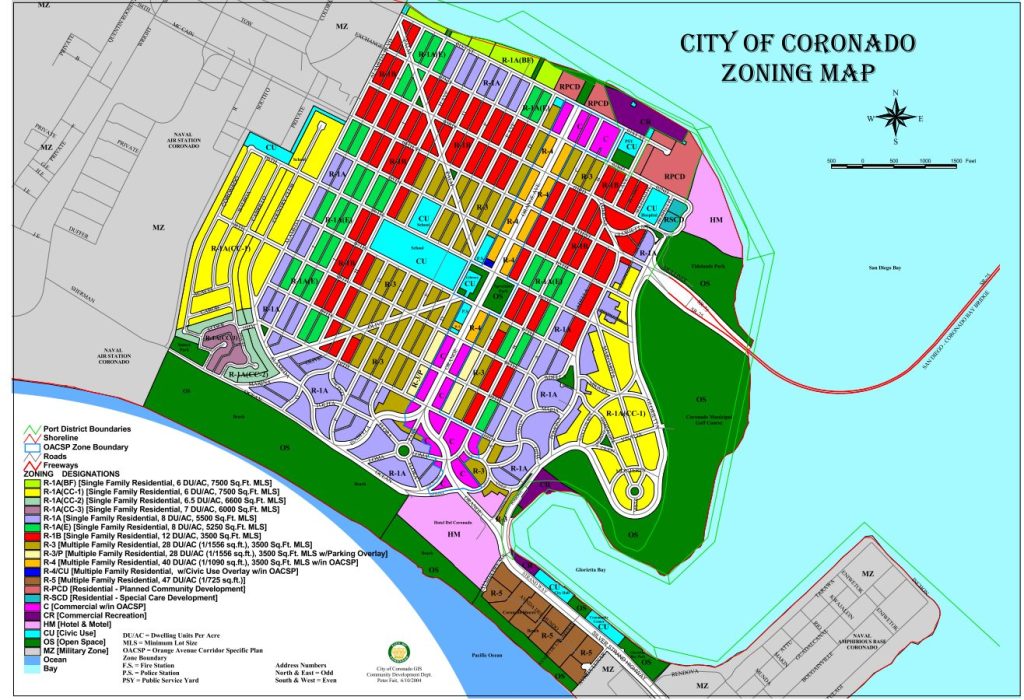Developments with income-restricted units are eligible for density bonuses that skirt zoning regulations, and Coronado is set to update its municipal code to reflect that. Bonuses include increased units as well as incentives like reduction in height restrictions or setbacks.
“I’m voting for this because it’s a fait accompli – we have no choice,” said planning commissioner Scott Metzger. “If we had a choice, I would very much vote against it.”
The Planning Commission on December 13 voted in favor of a recommendation that would change Coronado municipal code to reflect state laws for density bonuses. The matter will go before the Coronado City Council in January.
But even if Coronado did not update its codes, state law supersedes the city, and landowners could still go around Coronado’s government to take advantage of the program. The proposed change in municipal code refers back to the state program, simplifying, but not changing, the issue.
California adopted density bonuses in 1979 and expanded them in 2021 in an effort to bring more affordable housing to the state and help quash its housing crisis. Density bonuses are granted when a development of five or more units meets one of several criteria.

“Some of the examples of housing developments that could qualify for density bonus include developments that have at least 5 percent of the units designated for very low income housing, 10 percent dedicated to low income housing, and senior citizen housing,” said Jane Thornton, associate planner, at the Dec. 13 Planning Commission Meeting. “The more affordable units, the higher their possible density bonus.”
If criteria are met, developers are entitled to a density bonus awarded on a sliding scale. Prior to 2021, the law permitted a maximum bonus of 35% for most developments, but in 2021, the law was amended to expand the bonus to a maximum of 50% – or 80%, if all the units in a development are considered affordable.
Developers can also receive up to four concessions that relax site standards, such as setbacks and height limits for projects meeting income requirements. If a development reserves 17 percent of its units to low income households, it receives two concessions; if it reserves 24 percent, it receives three.
“The concessions do have to be tied to being a cost savings for the developer,” Thornton said. “The developers have to show what the concession would do for them, so it’s not a list that they choose from; they come to us with a list of ideas of what would be feasible.”
Practically, this means that a developer building a five-unit complex on a typical 50 x 140 foot lot zoned R-3 could instead build eight units – if 15 percent of them were designated very low income. The same developer could build seven units if 20 percent were designated low income.
A lot of the same size zoned R-4, with a maximum of seven base units, could qualify for up to 11 units instead, depending on its bonus allocation.
“For most cases, the maximum you could get is a 50 percent increase (in units),” Thornton said.

This would not change the zoning of a lot – an R-3 lot wouldn’t change to R-4 – but by skirting the zoning requirements through bonuses, larger complexes could pop up where they were not before allowed.
However, changing Coronado’s municipal code does not grant new power to developers; this has been possible since the density bonus laws were first introduced in 1979 and then expanded in 2021. Thornton said the planning office had only been able to find one property that has taken advantage thus far, and that was in 2006.
Commissioners questioned the program’s practicality.
“It wouldn’t work in Coronado because of the cost of everything,” Commissioner Jon Ryan said. “You couldn’t build an apartment building and rent it for $100 a unit. It would never pencil out. (…) It would work, maybe, in East Bernardino where the land is cheap, but I don’t see a developer marching in here and pulling this off.”
He referenced Thornton’s example, a 50 x 140-foot lot: “That’s $3.6 to 4 million for the dirt, and then we’re going to rent it out for nothing?”
A household of four earning $104,000 or less annually is considered low income in San Diego County, where the median income is $106,900. A low-income unit would rent at $2,604 monthly, according to the San Diego Housing Commission.
The additional units combined with federal programs offering developers assistance and tax credits for low-income housing projects and state programs that can be compounded may indeed make the development lucrative for developers. Generally, economies of scale come into play when adding more units to a building, though building out is easier than building up, since taller buildings run into elevator and sprinkler requirements, which can be costly.
The motion to recommend the City Council amend Coronado passed unanimously, but commissioners muttered as they filed out of the meeting.
“Unbelievable, the stuff Sacramento comes up with,” rang through the room.
The planning commission meeting of December 13, 2022 can be viewed here.




